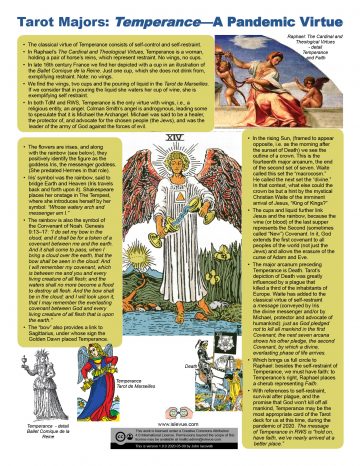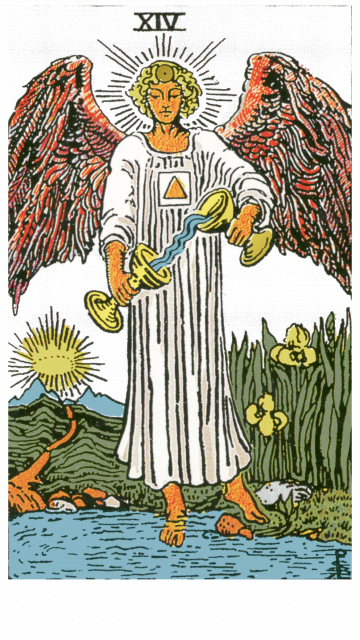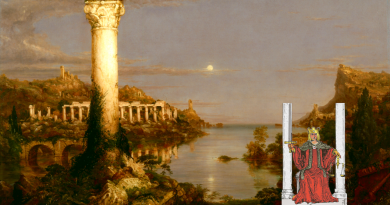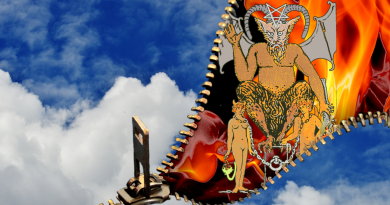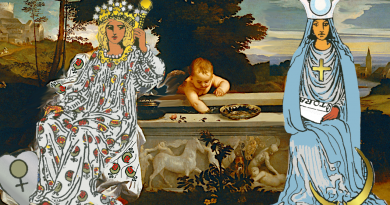Temperance—A Pandemic Virtue
I think I tend to interpret the tarot with a little less positive spin than most readers. So when I find an overwhelmingly uplifting message there during what seems to be the worst of times, a time of death, it astonishes me. Pleasantly, of course, but then, it should have been obvious. All we have to do is ask, "What trumps Death, number thirteen?" "Why, number fourteen, of course. Temperance!"
It appears to me that our mystical Christian maniac, A.E. Waite, has instructed his resident pixie of a graphics artist, Ms. Colman Smith, to provide hints in the way of some flowers and a crown. Voilà! Here go I, looking for a bit of exemplary virtue in the Tarot at this difficult time, stumbling across a message of hope specifically after a time of the plague.
Waite has overlaid an extraordinary, two-part message upon Temperance. It is that firstly, though many may die in times of pandemic, God made a promise (after the Great Flood), in the form of the rainbow, to never kill off the human race again. Secondly, that the light and joy of the divine kingdom, AKA the second coming, is imminent.
You don’t have to believe in Jesus to be moved by these messages. Though I’m not particularly religious, I am somewhat spiritual, and personally find this wonderful. I don’t believe in a literal second coming (and have a few doubts about the first). But I do think this is a perfect example of Tarot’s ability to touch a person deep inside with an unexpected insight which happened to be exactly what was needed, when it was needed.
This post is the third in our series on the Virtues during this time of the Worldwide Pandemic of 2020. The post continues a format—one page, one basic thought—depicting a single aspect of a major arcanum. So much has already been written about each of the major arcana, I see no need to repeat the general literature.
The format centers around a graphic, usually featuring the card itself, that sheds light on a single factor that helps make that arcanum what it is, along with (hopefully) a brief amount of text. Note the higher quality PDF download will be easier to read. Much of the text in the main section below repeats the text in the PDF, though this post includes some additional "editorial comments" not present in the PDF.
Trumping Death
The classical virtue of Temperance consists of self-control and self-restraint. It is the third of the classical virtues portrayed in the major arcana. Unlike Fortitude and Justice, its definition has come down to us from the Greeks relatively clear and unchanged, though artistic representations of it have evolved.
-
In Raphael’s The Cardinal and Theological Virtues, Temperance is a woman, holding a pair of horse’s reins, which represent restraint. Note however, she has no wings, and no cups.
-
In late 16th century France we find her depicted with a cup in an illustration of the Ballet Comique de la Reine. Just one cup, which she does not drink from, exemplifying restraint. And though she has her cup, she has no wings.
- We do find the wings, two cups and the pouring of liquid in the Tarot de Marseilles. If we consider that in pouring the liquid she waters her cup of wine, she is exemplifying self restraint. We should note that the twentieth century temperance movement took the watering-down-the-wine concept and appropriated this virtue for its own.
Though modern day people may think first of alcohol prohibition when considering temperance, it is clear that when we consider the classical virtue of Temperance that it’s a civil virtue, essential for peace within the community—temperate people don’t fight with each other for revenge or because they wish to steal another’s wealth. By the middle ages, this may have narrowed somewhat. Wikipedia states that "In the Christian religion, temperance is a virtue that moderates attraction and desire for pleasure and provides balance in the use of created goods. St. Thomas calls it a disposition of the mind which binds the passions. Temperance is believed to combat the sin of gluttony."
Note that in both TdM and RWS, Temperance is the only virtue with wings, i.e., a religious entity, an angel.
Colman Smith’s figure is androgynous, leading some to speculate that rather than the classical female figure representing Temperance, it is instead Michael the Archangel. Michael was said to be a healer, the protector of, and advocate for the chosen people (the Jews), and was the leader of the army of God against the forces of evil. Some also say that Michael is the angel described in the Book of Revelation, with a rainbow above his head and one foot on water, one on land.
Though the more religious aspect of this point of view might explain an angel, it doesn’t necessarily point to Michael. Or it can be a portmanteau symbol, incorporating more than one idea. There are two symbols to consider which I think may be of importance:
- The flowers are irises, and along with the rainbow (see below), they positively identify the figure as the goddess Iris, the messenger goddess. (She predated Hermes in that role).
- Iris’ symbol was the rainbow, said to bridge Earth and Heaven (Iris travels back and forth upon it). Shakespeare places her onstage in The Tempest, where she introduces herself by her symbol: "Whose watery arch and messenger am I."
- The rainbow is also the symbol of the Covenant of Noah. Genesis 9:13–17:
I do set my bow in the cloud, and it shall be for a token of a covenant between me and the earth. And it shall come to pass, when I bring a cloud over the earth, that the bow shall be seen in the cloud: And I will remember my covenant, which is between me and you and every living creature of all flesh; and the waters shall no more become a flood to destroy all flesh. And the bow shall be in the cloud; and I will look upon it, that I may remember the everlasting covenant between God and every living creature of all flesh that is upon the earth.
- The "bow" also provides a link to Sagittarius, under whose sign the Golden Dawn placed Temperance.
Robert M. Place in The Tarot: History, Symbolism, and Divination states that there are older versions of the Temperance arcanum with a rainbow painted in the sky behind the head of the figure. I haven’t been able to find an illustration to include, but I’m sure that Place is correct.
The rainbow and Noahic Covenant are recurring themes in the RWS tarot. This would not be the first reference to the Noahic Covenant without actually painting a rainbow. And this is what I think that implies:
- In the rising Sun, (framed to appear opposite, i.e. as the morning after the sunset of Death) we see the outline of a crown. This is the fourteenth major arcanum, the end of the second set of seven. Waite called this set the "macrocosm." He called the next set the "divine." In that context, what else could the crown be but a hint by the mystical Christian Waite of the imminent arrival of Jesus, "King of Kings?"
- The cups and liquid further link Jesus and the rainbow, because the wine (or blood) of the last supper represents the Second (sometimes called "New") Covenant. In it, God extends the first covenant to all peoples of the world (not just the Jews) and allows the erasure of the curse of Adam and Eve.
- The major arcanum preceding Temperance is Death. Tarot’s depiction of Death was greatly influenced by a plague that killed a third of the inhabitants of Europe. Waite has added to the classical virtue of self-restraint a message (conveyed by Iris the divine messenger and/or by Michael, protector and advocate of humankind): just as God pledged not to kill all mankind in the first Covenant, the next seven arcana shows his other pledge, the second Covenant, by which a divine, everlasting phase of life arrives.
- Which brings us full circle to Raphael: besides the self-restraint of Temperance, we must have faith: to Temperance’s right, Raphael places a cherub representing Faith.
- With references to self-restraint, survival after plague, and the promise that God won’t kill off all mankind, Temperance may be the most appropriate card of the Tarot deck for us at this time, during the pandemic of 2020. The message of Temperance in RWS is "hold on, have faith, we’ve nearly arrived at a better place."
Éliphas Lévi believed that ancient cultures imbued Tarot with magical symbolism that provided a universal key to all ideas. Perhaps the somewhat lesser historical baggage that has accumulated in the major arcana since the renaissance is enough to put some truth in Lévi’s idea.
Copyright Information: This article’s content by John Iacovelli, for islevue.com is licensed under a Creative Commons Attribution 4.0 International License. Permissions beyond the scope of this license may be available at mailto:admin@islevue.com.
This article’s content by John Iacovelli, for islevue.com is licensed under a Creative Commons Attribution 4.0 International License. Permissions beyond the scope of this license may be available at mailto:admin@islevue.com.
The Wikipedia articles’ copyrights are governed by the Creative Commons share-alike license.
Feature collage backgrounds by Klaus Dieter vom Wangenheim and chiplanay from Pixabay

